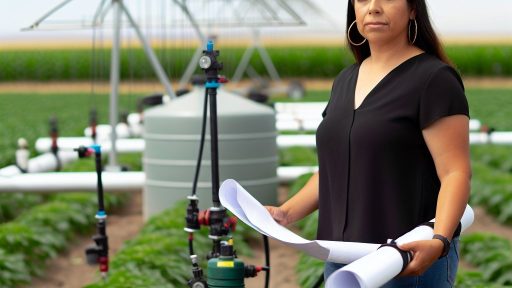Understanding the Impact of Transportation Costs on Agribusiness Profitability
The Role of Transportation in Agribusiness
Transportation plays a crucial role in agribusiness efficiency.
It directly affects the cost of goods sold and profitability.
Ultimately, effective transportation systems enhance competitive advantage.
Identifying Key Transportation Costs
Identifying key transportation costs is vital for improving profitability.
Major costs include fuel expenses, labor, and maintenance.
Additionally, unexpected delays can lead to financial losses.
Improper route management also adds unnecessary expenses.
The Impact of Rising Fuel Prices
Rising fuel prices significantly impact agribusiness budgets.
High fuel costs increase overall transportation expenses.
This scenario necessitates better fuel management strategies.
Companies must explore options for fuel efficiency.
Strategies to Reduce Transportation Costs
Focusing on strategies to reduce transportation costs is essential.
Implementing route optimization can maximize operational efficiency.
Using technology helps in real-time tracking of shipments.
Moreover, consolidating shipments lowers costs significantly.
Transform Your Agribusiness
Unlock your farm's potential with expert advice tailored to your needs. Get actionable steps that drive real results.
Get StartedEvaluating the Impact of Transportation Technology
Transportation technology can lead to automated processes.
Investing in logistics software streamlines operations.
Real-time data assists in making informed decisions.
Using GPS and routing software improves delivery times.
Mitigating Risks of Transportation Delays
Transportation delays create financial challenges for agribusinesses.
Establishing backup plans can help mitigate these risks.
Utilizing multiple carriers enhances flexibility and reliability.
Additionally, building strong relationships with suppliers fosters collaboration.
Collaboration within the Supply Chain
Collaboration within the supply chain can lead to shared savings.
Partners can work together to reduce transportation costs.
Coordinating schedules ensures timely deliveries at lower expenses.
This approach creates a win-win situation for all involved.
Evaluating Transportation Modes
Trucks
Trucks offer flexibility in agribusiness logistics.
They can access remote locations easily.
Furthermore, they provide door-to-door service.
This option is generally faster for short distances.
However, high fuel costs can affect profitability.
It’s crucial to consider payload capacity as well.
Road regulations and maintenance are important factors too.
Rail
Rail transportation is cost-effective for bulk shipments.
It has a lower environmental impact compared to trucks.
Additionally, it can handle large quantities of goods.
Rail networks cover vast regions effectively.
However, rail transport lacks flexibility in routing.
Showcase Your Farming Business
Publish your professional farming services profile on our blog for a one-time fee of $200 and reach a dedicated audience of farmers and agribusiness owners.
Publish Your ProfileConsequently, additional trucking may be necessary.
Delivery times can also vary depending on schedules.
Maritime Options
Maritime transport is excellent for international trade.
It reduces transportation costs for large shipments.
Moreover, it offers significant cargo capacity.
Shipping by sea is environmentally friendly as well.
Nonetheless, transit times can be lengthy.
Additionally, legal regulations vary by country.
Port availability can also impact shipping efficiency.
Comparative Analysis
When evaluating transportation costs, consider distance and volume.
For short distances, trucks may offer the best solution.
For large volumes over long distances, rail could be ideal.
Maritime options shine in international contexts.
Always assess the total logistics costs for clarity.
Collaboration with logistics professionals enhances efficiency.
Ultimately, a mixed transportation strategy may yield the best results.
Implementing Route Optimization Technology
Understanding Route Optimization
Route optimization refers to the use of technology to determine the best routes for transportation.
This approach significantly reduces mileage and fuel consumption.
Routing software can analyze various routes in real-time.
It accounts for traffic patterns, road conditions, and vehicle capacities.
Benefits of Route Optimization
Implementing optimized routes leads to substantial cost savings.
Businesses can reduce fuel expenses by minimizing unnecessary mileage.
Additionally, shorter routes decrease wear and tear on vehicles.
This can extend the life of transportation assets, such as trucks and trailers.
Choosing the Right Technology
Many software options are available for route optimization.
Some popular choices include Geotab, Route4Me, and OptimoRoute.
Each offers unique features and pricing structures.
Organizations should choose technology that fits their specific needs.
Implementation Steps
First, gather data on current transportation routes.
Next, input this data into the chosen optimization software.
The software will analyze routes and suggest improvements.
Finally, assess the recommended routes and implement them.
Measuring Success
Regularly evaluate the performance of optimized routes.
Track fuel consumption, delivery times, and overall costs.
Adjust strategies based on performance metrics.
Continuous improvement will enhance efficiency and cost savings.
Find Out More: Enhancing Inventory Management for Online Farming
Leveraging Local Sourcing to Minimize Transportation Distances
Understanding Local Sourcing
Local sourcing refers to obtaining goods from nearby suppliers.
This practice reduces transportation distances significantly.
Consequently, local sourcing decreases fuel consumption.
Showcase Your Farming Business
Publish your professional farming services profile on our blog for a one-time fee of $200 and reach a dedicated audience of farmers and agribusiness owners.
Publish Your ProfileMoreover, it lessens greenhouse gas emissions from transportation.
Benefits of Local Sourcing
Local sourcing offers several advantages for agribusinesses.
- It lowers transportation costs associated with long-distance shipping.
- It supports local economies and farmers.
- Additionally, it enhances product freshness and quality.
Implementing Local Sourcing Strategies
To effectively implement local sourcing, companies must identify regional suppliers.
Networking with local farmers can yield fruitful partnerships.
Offering incentives encourages more suppliers to participate.
Furthermore, businesses should promote local sourcing initiatives to customers.
Measuring Transportation Savings
Tracking transportation costs plays a crucial role in evaluating local sourcing benefits.
Businesses can compare costs of local versus distant suppliers.
Moreover, conducting regular audits enables continuous improvement.
Ultimately, understanding financial impacts fosters better sourcing strategies.
Challenges in Local Sourcing
Despite its advantages, local sourcing has challenges.
- Availability of specific products may be limited locally.
- Pricing can fluctuate based on local market conditions.
- Additionally, logistics may require adjustments for local supplies.
Businesses must develop solutions to navigate these challenges.
Future Directions for Local Sourcing
Local sourcing represents a promising approach for reducing transportation costs.
The trend towards sustainability supports its growth in agribusiness.
By prioritizing local sourcing, businesses enhance efficiency and environmental responsibility.
Delve into the Subject: Waste Reduction Methods In Farming Operations
Negotiating Better Rates with Logistics Providers and Carriers
Understanding Your Needs
First, identify your specific transportation needs.
Consider the types of products you transport.
Next, evaluate the volume and frequency of shipments.
Additionally, define the geographic regions you cover.
Researching Logistics Providers
Conduct thorough research on potential logistics providers.
Look into their reputation and customer reviews.
Compare their services, network, and pricing structures.
Ensure they specialize in agricultural transportation.
Building Relationships
Establish strong relationships with your logistics providers.
Meet with them regularly to discuss your needs.
Communicate your goals and expectations clearly.
Trust and transparency foster better negotiations.
Negotiation Strategies
Approach negotiations with a clear strategy.
Start by presenting your research and data.
Highlight your shipping volume to leverage better rates.
Always be ready to walk away if terms don’t meet your needs.
Seeking Long-Term Contracts
Consider negotiating long-term contracts with providers.
Longer commitments often lead to favorable rates.
Evaluate contract terms to ensure flexibility and scalability.
Regularly review performance to ensure quality service.
Utilizing Technology
Leverage technology to streamline your logistics operations.
Use software for tracking shipments and managing schedules.
Analyze data to identify cost-saving opportunities.
Implement automation where feasible to improve efficiency.
Showcase Your Farming Business
Publish your professional farming services profile on our blog for a one-time fee of $200 and reach a dedicated audience of farmers and agribusiness owners.
Publish Your ProfileMonitoring and Adjusting
Continuously monitor your transportation costs and logistics performance.
Regularly review contracts and service levels.
Be proactive in making adjustments as needed.
Stay informed about market trends and pricing changes.
You Might Also Like: Implementing Agritourism to Diversify Farm Income
Exploring Shared Transportation Solutions Among Local Farmers and Cooperatives
Benefits of Shared Transportation
Shared transportation reduces costs for farmers significantly.
It enhances the efficiency of logistics in agribusiness.
Moreover, it minimizes the environmental impact associated with individual transport.
Collaborative efforts also improve local community relationships.
Identifying Suitable Partners
Local farmers can benefit from identifying nearby cooperatives.
They should evaluate the size and type of products they transport.
Additionally, considering the transportation needs of nearby farms is crucial.
Communication between partners helps in establishing effective partnerships.
Implementing a Shared Transport System
Firstly, farmers need to organize regular meetings to discuss logistics.
Then, they can explore existing platforms for shared transportation.
Additionally, farmers should establish clear schedules for sharing vehicles.
Consistently updating the schedule ensures efficiency in transport.
Challenges and Solutions
One challenge is coordinating pick-up and drop-off points.
Farmers can solve this by using centralized locations for collections.
Another concern is trust among participating farmers.
Building strong relationships through transparency can mitigate this issue.
Future Outlook
The future looks promising for shared transportation in agribusiness.
As more farmers engage, they can negotiate better rates with logistics providers.
Furthermore, technology will play a crucial role in streamlining operations.
Embracing shared transport solutions can reshape agribusiness.
Learn More: Building Resilient Supply Chains for the Farming Industry

Analyzing the Role of Supply Chain Management in Lowering Transportation Expenses
Importance of Effective Supply Chain Management
Effective supply chain management plays a crucial role in reducing transportation costs.
It streamlines operations, improving the overall efficiency of agribusinesses.
Moreover, it ensures timely delivery of goods to their destinations.
Enhancing Coordination Among Stakeholders
Coordination among suppliers, producers, and distributors is vital.
This collaboration minimizes delays and reduces transportation expenses.
Regular communication fosters transparency and builds trust among parties.
Utilizing Technology for Optimization
Modern technology enhances supply chain visibility and efficiency.
Leveraging data analytics improves route planning and inventory management.
As a result, businesses can respond swiftly to market changes.
Implementing Cost-Effective Transportation Solutions
Implementing reliable transportation solutions lowers operational costs.
Choosing the right transportation modes can significantly influence expenses.
- For instance, rail transport is often cheaper for bulk shipments.
- Additionally, utilizing third-party logistics providers can reduce overhead costs.
Regularly Reviewing and Adjusting Strategies
Continuous assessment of supply chain strategies is essential.
This practice helps identify areas for improvement and cost reduction.
Regular reviews can uncover inefficiencies that need addressing.
Showcase Your Farming Business
Publish your professional farming services profile on our blog for a one-time fee of $200 and reach a dedicated audience of farmers and agribusiness owners.
Publish Your ProfileInvesting in Fuel-Efficient Vehicles and Sustainable Practices
Importance of Fuel Efficiency
Fuel-efficient vehicles reduce overall transportation costs.
They help agribusinesses save money in the long run.
Moreover, these vehicles lower carbon emissions significantly.
This reduction benefits both the environment and public health.
Choosing the Right Vehicles
Selecting the right vehicles is crucial for success.
Electric and hybrid vehicles are excellent alternatives.
They promise lower fuel consumption and maintenance costs.
Additionally, consider vehicles designed for heavy loads.
These vehicles improve efficiency while transporting goods.
Implementing Sustainable Practices
Incorporating sustainable practices maximizes cost reduction.
Investing in route optimization software streamlines delivery.
This technology minimizes wasted fuel and time.
Furthermore, using real-time tracking enhances delivery efficiency.
These practices ultimately lead to increased customer satisfaction.
Training and Education
Training staff is essential for maximizing vehicle efficiency.
Educating employees on eco-friendly driving techniques proves beneficial.
This training reduces fuel consumption and wear on vehicles.
Additionally, implementing regular vehicle maintenance keeps them running optimally.
It also prevents costly repairs and downtime.
Collaborating with Logistics Partners
Forming partnerships with logistics companies streamlines transportation.
These partners can offer additional insights into efficiency.
They often have established networks that ensure timely deliveries.
Furthermore, they may provide access to advanced technologies.
This collaboration helps reduce costs across the supply chain.
Utilizing Data Analytics for Demand Forecasting and Efficient Loading
Importance of Demand Forecasting
Demand forecasting is essential for effective supply chain management.
It helps businesses predict future customer needs accurately.
Consequently, firms can allocate resources more efficiently.
Utilizing data analytics enhances the precision of these forecasts.
Data analytics processes large volumes of historical data quickly.
By analyzing this data, businesses identify trends and patterns.
Methods for Demand Forecasting
Various methods exist for demand forecasting in agriculture.
- Statistical techniques are common for analyzing historical data.
- Machine learning algorithms improve accuracy through pattern recognition.
- Consider using time series analysis for seasonal products.
- Integrating market research offers insights into consumer behavior.
Efficient Loading Practices
Efficient loading minimizes transportation costs significantly.
Optimized loading practices maximize cargo space utilization.
Data analytics aids in determining the most effective loading configurations.
Utilizing software for load planning improves overall efficiency.
Benefits of Integrating Data Analytics
Integrating data analytics benefits agribusinesses in multiple ways.
- It reduces waste by ensuring accurate inventory levels.
- The cost savings are noticeable through optimized routes.
- It enhances customer satisfaction with timely deliveries.
Data analytics transforms how agribusinesses approach logistics.
Thus, it provides a competitive edge in the market.
Incorporating Government Subsidies and Grants for Transportation Improvements
Understanding Transportation Costs
Transportation costs significantly impact agribusiness profitability.
Farmers often face high expenses for moving goods to markets.
Showcase Your Farming Business
Publish your professional farming services profile on our blog for a one-time fee of $200 and reach a dedicated audience of farmers and agribusiness owners.
Publish Your ProfileTherefore, reducing these costs is essential for sustainable operations.
Exploring Government Support
Government subsidies play a key role in reducing transportation costs.
Many programs aim to assist farmers and agribusinesses financially.
These funds can alleviate the burden of transportation expenses.
Additionally, grants can help cover the costs of infrastructure improvements.
Types of Available Programs
Several types of government programs support transportation in agriculture.
- Direct grants for transportation projects enhance logistics.
- Subsidies for fuel and maintenance reduce operating costs.
- Tax incentives encourage investment in more efficient vehicles.
Application Process for Subsidies and Grants
The application process for subsidies can be straightforward.
Farmers should prepare documentation of their needs and expenses.
Additionally, understanding eligibility requirements is crucial for success.
Consulting with local agricultural offices can provide valuable guidance.
Examples of Successful Implementations
For instance, the Green Farm Initiative secured funding for new trucks.
This investment led to a 30% reduction in transportation costs.
Similarly, the Harvest Grant Program helped build a new distribution center.
Such improvements streamline operations and boost overall profitability.
Future Trends in Subsidies
Looking ahead, government support for transportation may expand further.
Increased focus on sustainability will drive innovation in logistics.
Also, digital tools may be integrated into subsidy programs.
This evolution will help farmers access funds more efficiently.
Additional Resources
Access to Affordable, Nutritious Food Is Limited in “Food Deserts …




